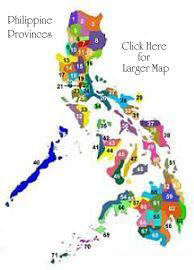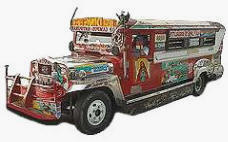Originally based in mainland China, the Republic of China currently governs the island of Taiwan (known  in the past as Formosa), which forms over 99% of its current territory,as well as Penghu, Kinmen, Matsu, and other minor islands. Neighboring states include China to the west, Japan to the east and northeast, and the Philippines to the south. Taipei is the capital city and economic and cultural centre of the country, and New Taipei is the largest city by population.
in the past as Formosa), which forms over 99% of its current territory,as well as Penghu, Kinmen, Matsu, and other minor islands. Neighboring states include China to the west, Japan to the east and northeast, and the Philippines to the south. Taipei is the capital city and economic and cultural centre of the country, and New Taipei is the largest city by population.
 in the past as Formosa), which forms over 99% of its current territory,as well as Penghu, Kinmen, Matsu, and other minor islands. Neighboring states include China to the west, Japan to the east and northeast, and the Philippines to the south. Taipei is the capital city and economic and cultural centre of the country, and New Taipei is the largest city by population.
in the past as Formosa), which forms over 99% of its current territory,as well as Penghu, Kinmen, Matsu, and other minor islands. Neighboring states include China to the west, Japan to the east and northeast, and the Philippines to the south. Taipei is the capital city and economic and cultural centre of the country, and New Taipei is the largest city by population.
Once upon a time, Taipei’s streets were chock-full of taxis, buses and
racing scooters, and its sidewalks congested with people and trash. The
air was foul, and the architecture – shrines, temples and old colonial
buildings aside – was ugly. Central planning seemed sporadic or even
nonexistent. In the late 1980s, as the scars of former martial law began
healing, citizens realised that while they were materially rich, their
quality of life was poor. They demanded change and over the next decade,
city planners did what you’d expect those schooled in Asia’s most computer-savvy society to do: they played a protracted game of SimCity, only for keeps.
The mix of different influences that makes up modern Taiwan is also
neatly showcased by the island’s cuisine – a lip-smacking blend of
Chinese, Japanese and aboriginal fare. Like many aspects of life here
though, its full context only becomes really apparent when you look at
the island’s history. Japan ruled for five decades, following which – in
1949 – supporters and soldiers of the Chinese Nationalist Party fled
here after being defeated by the forces of Chairman Mao in the Chinese
Civil War. To this day, Taiwan remains a product of this period – a
maverick state still viewed with uneasiness by Beijing.
 But history buff or no history buff, there’s much to enjoy here for
the casual traveller. In general terms it’s a safe, hospitable
destination, free of much of the overwhelming scale that can make China
itself daunting for some tourists. That’s not to say Taiwan lacks the
potential for independent adventure, of course – far from it – but in
many ways it’s a more straightforward travel prospect than the mainland.
But history buff or no history buff, there’s much to enjoy here for
the casual traveller. In general terms it’s a safe, hospitable
destination, free of much of the overwhelming scale that can make China
itself daunting for some tourists. That’s not to say Taiwan lacks the
potential for independent adventure, of course – far from it – but in
many ways it’s a more straightforward travel prospect than the mainland. In former times, Taiwan was known as Formosa, a word derived from the
Portuguese for “beautiful island”, and it’s a sobriquet that still
seems apt. Away from the sleek towers and pulsing neon of the cities,
it’s the valleys, lakes and gorges of the countryside that tend to leave
the greatest impression. The fact that comparatively few leisure
tourists make it to Taiwan in the first place is more to do with a lack
of awareness than a lack of things to do – hikers, cyclists, divers,
surfers, pilgrims, gourmands and luxury-lovers will all find a little
slice of heaven here. True, a location bang on the Tropic of Cancer
means the weather can be changeable, but even when the brollies are up,
this is an absorbing place to visit.
In former times, Taiwan was known as Formosa, a word derived from the
Portuguese for “beautiful island”, and it’s a sobriquet that still
seems apt. Away from the sleek towers and pulsing neon of the cities,
it’s the valleys, lakes and gorges of the countryside that tend to leave
the greatest impression. The fact that comparatively few leisure
tourists make it to Taiwan in the first place is more to do with a lack
of awareness than a lack of things to do – hikers, cyclists, divers,
surfers, pilgrims, gourmands and luxury-lovers will all find a little
slice of heaven here. True, a location bang on the Tropic of Cancer
means the weather can be changeable, but even when the brollies are up,
this is an absorbing place to visit.
Attractive places:
Taipei Night Market
Shilin - suitable for all ages. Huge variety of shopping + food. Alight
at JianTan station (DO NOT alight at shilin station). Size of night
market - Huge!
Liaoning - although it still appears on the tourist map that we got from airport, it no longer exist.
 Shida
- Alight at Tai Power Building station. This night market is more for
youngsters due to it proximity to the university. Be prepared to squeeze
with a few thousand teenagers in the alley. Not much food, mostly
apparels for teenagers. Size of night market - medium!
Shida
- Alight at Tai Power Building station. This night market is more for
youngsters due to it proximity to the university. Be prepared to squeeze
with a few thousand teenagers in the alley. Not much food, mostly
apparels for teenagers. Size of night market - medium!
Huaxi - suitable for all ages. Alight at Longshan temple station. Size of night market - small!
Danshui - this night market is by the riverside. It is the best night market I have been to. suitable for all ages. Size of night market - medium!
Liaoning - although it still appears on the tourist map that we got from airport, it no longer exist.
 Shida
- Alight at Tai Power Building station. This night market is more for
youngsters due to it proximity to the university. Be prepared to squeeze
with a few thousand teenagers in the alley. Not much food, mostly
apparels for teenagers. Size of night market - medium!
Shida
- Alight at Tai Power Building station. This night market is more for
youngsters due to it proximity to the university. Be prepared to squeeze
with a few thousand teenagers in the alley. Not much food, mostly
apparels for teenagers. Size of night market - medium! Huaxi - suitable for all ages. Alight at Longshan temple station. Size of night market - small!
Danshui - this night market is by the riverside. It is the best night market I have been to. suitable for all ages. Size of night market - medium!
 Raohe
- it was raining heavily when we were there, good variety of food +
shopping. But it will be challenging for those who travel by
train(metro) as the "nearest" stations Taipei CityHall and Houshanpi are
at least 30 mins'walk away. Size of night market - medium!
Raohe
- it was raining heavily when we were there, good variety of food +
shopping. But it will be challenging for those who travel by
train(metro) as the "nearest" stations Taipei CityHall and Houshanpi are
at least 30 mins'walk away. Size of night market - medium!If you have time to travel outside Taipei - Keelung 's Miaokou night market is a real food paradise.
Beitou Hot Springs
Taiwan is well-known for its hot springs but did you actually know right
in the heart of Nantou (near Taichung), there is this fantastic place
called Sun Moon Lake, which is a must visit as the sight of it is simply
breathtaking and if you choose the right hotel, the stay there is
simply magical. 
How to get there from taipei:
Take the high speed rail from taipei to taichung. From taichung high speed rail, you either hail for a cab that costs about NT$1000 to get to sun moon lake or you can take the bus that costs NT$200 to get there. But be mindful that the bus has its own schedule so you have to be at the taichung high speed rail station by a certain time, if you miss it, it might be an hour wait to half an hour's wait before the next bus picks you up.
===BEITOU HOTSPRING=====
Ok amongst all the other hot springs in Taiwan, Beitou hot springs are one of the most accessible ones, take a train ride from wherever you are to Beitou MRT station and depending on where is your hotel, resort, you may or may not need to transfer on to the Hsin Beitou MRT station, which is one station away from Beitou MRT station.

How to get there from taipei:
Take the high speed rail from taipei to taichung. From taichung high speed rail, you either hail for a cab that costs about NT$1000 to get to sun moon lake or you can take the bus that costs NT$200 to get there. But be mindful that the bus has its own schedule so you have to be at the taichung high speed rail station by a certain time, if you miss it, it might be an hour wait to half an hour's wait before the next bus picks you up.
===BEITOU HOTSPRING=====

Ok amongst all the other hot springs in Taiwan, Beitou hot springs are one of the most accessible ones, take a train ride from wherever you are to Beitou MRT station and depending on where is your hotel, resort, you may or may not need to transfer on to the Hsin Beitou MRT station, which is one station away from Beitou MRT station.
A good tip is probably go
to this hot spring first before exploring taipei proper because
 sometimes these spa / hot spring resort has its own promotion going on
where you can buy a package of sessions to the private hot spring bath
rooms at a rate cheaper than the once off session.
sometimes these spa / hot spring resort has its own promotion going on
where you can buy a package of sessions to the private hot spring bath
rooms at a rate cheaper than the once off session.
It is more hygenic to be in a hot bath spring with your friends rather than with everyone else, it is like a private jacuzzi with your friends, where you can talk about anything.
 sometimes these spa / hot spring resort has its own promotion going on
where you can buy a package of sessions to the private hot spring bath
rooms at a rate cheaper than the once off session.
sometimes these spa / hot spring resort has its own promotion going on
where you can buy a package of sessions to the private hot spring bath
rooms at a rate cheaper than the once off session. It is more hygenic to be in a hot bath spring with your friends rather than with everyone else, it is like a private jacuzzi with your friends, where you can talk about anything.
Chiang Kai Shek (CKS) Memorial
The imposing CKS Memorial includes exhibits of items from Chiang's life and times; they range from photographs to his limousine.
.JPG)
Much vilified for "losing China" through tolerating corrupt underlings and for his own authoritarian rule on Taiwan, Chiang was nonetheless a far more tolerant and infinitely less cruel ruler than his nemesis Mao Tse-tung.
.JPG)
Much vilified for "losing China" through tolerating corrupt underlings and for his own authoritarian rule on Taiwan, Chiang was nonetheless a far more tolerant and infinitely less cruel ruler than his nemesis Mao Tse-tung.
Danshui
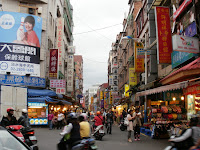 Danshui is located at the end of the Danshui Line of the MRT. It is a
port located on the Danshui River and has many buildings of historical
interest as well as some interesting Chinese temples and busy shopping
streets.
Danshui is located at the end of the Danshui Line of the MRT. It is a
port located on the Danshui River and has many buildings of historical
interest as well as some interesting Chinese temples and busy shopping
streets.Buildings of historical interest include:
The Red Castle - now a restaurant this picturesque building was originally built by the British. As a restaurant it has quite good food and excellent views.
Fort San Domingo - interesting and well preserved building originally built by the spanish, then taken over by the dutch, then turned into the British Consulate. Well worth a look.
George Leslie MacKay was a Canadian missionary based in Danshui. He built many hospitals and schools in the area and is held in high regard by people in this area even today. There are lots of old buildings associated with George Leslie MacKay including Oxford College (located inside the campus of Alethia University), Danshui Church and Tamkang High School which includes MacKay's grave and a small foreigner's cemetery.

The little white house - lovely old building which used to be the port's customs house.
There is a statue of MacKay in the middle of town.
smile~
(^-^)
(^-^)








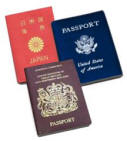
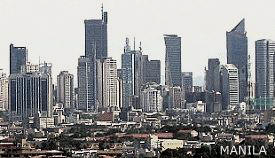 provided that they have valid tickets for their return journey to
their port of origin or to their next travel destination port and that
their
passports are valid for a period of at least six (6) months.
Extension of stay is available at the
provided that they have valid tickets for their return journey to
their port of origin or to their next travel destination port and that
their
passports are valid for a period of at least six (6) months.
Extension of stay is available at the 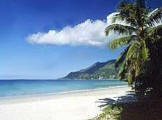 The
Philippine
islands are divided into three groups: Luzon, Visayas, and Mindanao.
The Luzon islands include Luzon itself, Mindoro, Palawan, Masbate, and
other
smaller islands. The Visayas is a group of several small islands,
the largest of which are: Panay, Bohol, Negros, Cebu, Leyte, and Samar.
Mindanao island includes
Mindanao island itself and the Sulu Archipelago, composed of
Tawi-Tawi, Basilan and Sulu. Each island group has a Philippine
destination worth visiting.
The
Philippine
islands are divided into three groups: Luzon, Visayas, and Mindanao.
The Luzon islands include Luzon itself, Mindoro, Palawan, Masbate, and
other
smaller islands. The Visayas is a group of several small islands,
the largest of which are: Panay, Bohol, Negros, Cebu, Leyte, and Samar.
Mindanao island includes
Mindanao island itself and the Sulu Archipelago, composed of
Tawi-Tawi, Basilan and Sulu. Each island group has a Philippine
destination worth visiting.